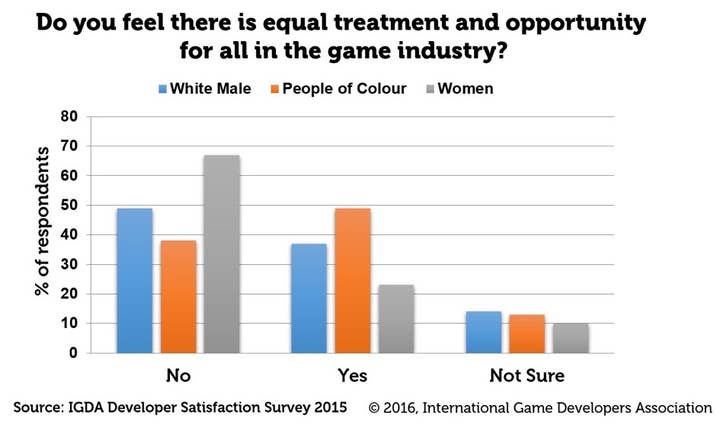IGDA survey underscores industry's racial, gender disparities
Only 3% of non-white developers hold senior management roles, and only 3% of women earn more than $150,000
The International Game Developers Association has released another wave of results from its Developer Satisfaction Survey. The group today released an assortment of statistics underscoring continued disparities throughout the games industry for women and developers of color, as shown by the results of its 2015 survey.
IGDA executive director Kate Edwards told GamesIndustry.biz that there continue to be significant differences in pay and opportunity between demographics. While 10% of men earn $150,000 or more, only 3% of women in the industry find themselves in that top pay range. Women and men were almost equally likely to report working in a management role of some kind (37% of women, 38% of men), but women were less likely to hold senior management positions (19% of women, compared to 23% of men).
The picture is more striking for developers of color, where only 3% of respondents held a senior management role. When asked about the top pay range figure for developers of color, Edwards said that 45% of white developers make over $75,000 a year, while only 35% of non-white developers make that much. Developers of color are also over-represented at the low end of the income scale, where 26% of non-white developers made less than $15,000 annually, compared to 17% of white developers.
Those disparities are perceived differently by each group. When asked if they felt there is equal treatment and opportunity for all in the games industry, 49% of non-white developers said there was. That was up from 23% in the 2014 Developer Satisfaction survey, but Edwards couldn't point to any specific factor in the time between those surveys that could be attributed for such a leap.
Speaking more generally, women and men alike were increasingly likely to say the industry failed to provide equal treatment and opportunity. 67% of women saw the industry as not providing that equality, up from 55% in 2014. Meanwhile, 46% of men saw the industry playing field as being slanted against some, up from 44% the year before.
"I think a big part of it is we're seeing the perception from two angles," Edwards said. "The men basically see that yes, there is a problem, but it's not as big a problem as the women see it from their perspective."
As for how to make the industry more equitable for developers of all kinds, there are a number of problems, among them the lack of a good model to follow. Hollywood and Silicon Valley are the most obvious parallels for the games industry from a creative and technical perspective, but both places are themselves struggling with issues of race and gender representation within the workforce, arguably even moreso than the games industry.
"I think there's an opportunity for the game industry to actually show some level of leadership, being an artistic-technical kind of industry that we are. We can actually make changes that better model those who are playing our games and using our products," Edwards said, adding, "While there are a lot of good programs out there attempting to do this, especially on local and regional levels, I think the industry as a whole needs to do even more and do a bigger push to try and attract more people of color, more women, and more people who should be a part of this industry. We want them to be a part of this industry because we know the more diverse our workforce, the more diverse our game types and content and gameplay can potentially be."


